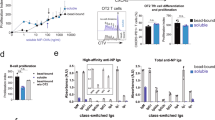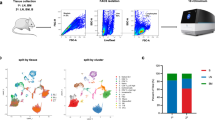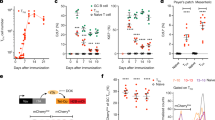Abstract
HUMORAL antibodies are produced by lymphocytes of bone-marrow or bursal origin (B cells). Some antigens are apparently capable of stimulating B cells and inducing a response directly but many other antigens are dependent on the cooperative help of lymphocytes of thymic origin (T cells). There are at least two forms of such cooperation between B and T cells. One type of cooperation is ‘nonspecific’ where T cells once activated by specific antigen release a nonspecific factor which can then facilitate the responses of B cells to certain other non-related antigens1. The other well studied cooperative mechanism is known as ‘specific cooperation’ and classically this has been analysed with the use of ‘hapten-carrier’ systems2. The exact nature of this cooperative event is not known. It may be that cooperation occurs through widely diffusible specific factors released by T cells, or alternatively the cooperating T and B cells may need to come into close or direct contact. We have studied helper T-cell function in a microculture system with the aim of determining whether a single helper T cell could activate one or many B cells. Experiments of this type have previously been performed by repopulating mice with limiting numbers of immunocompetent cells and examining the resulting foci of antibody activity. When T cells were the limiting population some have found these foci to be heterogeneous3 and others have found them to be monoclonal4,5. Similar in vitro studies have also suggested marked restriction in the B-cell response where T helper cells were limiting6. Here we present direct evidence to support the findings demonstrating restriction. We conclude that in the conditions used, one specific helper T cell cooperated with one B cell only.
This is a preview of subscription content, access via your institution
Access options
Subscribe to this journal
Receive 51 print issues and online access
$199.00 per year
only $3.90 per issue
Buy this article
- Purchase on Springer Link
- Instant access to full article PDF
Prices may be subject to local taxes which are calculated during checkout
Similar content being viewed by others
References
Waldmann, H. & Munro, A. Eur. J. Immun. 4, 410–416 (1973).
Mitchison, N. A. Eur. J. Immun. 1, 10–17 (1971).
Cambpell, P. A. Cell. Immun. 2, 250–258 (1971).
North, J. R. & Feinstein, A. Eur. J. Immun. 3, 784–789 (in the press).
Sullman, S. F. & Feinstein, A. Eur. J. Immun. (in the press).
Waldmann, H., Lefkovits, I. & Feinstein, A. Immunology 31, 353–362 (1976).
Lefkovits, I. Eur. J. Immun. 2, 360–366 (1972).
Waldmann, H., Pope, H. & Lefkovits, I. Immunology 31, 343–352 (1976).
Feldmann, M. J. exp. Med. 136, 737–760 (1972).
Taussig, M. J. Nature 248, 234–236 (1974).
Lefkovits, I. & Waldmann, H. Immunology 32, 915.
Herzenberg, L. A., Okamura, K. & Metzler, M. C. Transplant. Rev. 27, 57–83 (1975).
Kishimoto, T. & Ishizaka, K. J. Immun. 111, 720–732 (1973).
Lieu, S. H., Koo, P. H. & Cebra, J. J. J. Immun. 113, 677–687 (1974).
Phillips, J. M. & Dresser, D. W. Eur. J. Immun. 3, 524–527 (1973).
Author information
Authors and Affiliations
Rights and permissions
About this article
Cite this article
PHILLIPS, J., WALDMANN, H. Monogamous T helper cell. Nature 268, 641–642 (1977). https://doi.org/10.1038/268641a0
Received:
Accepted:
Issue Date:
DOI: https://doi.org/10.1038/268641a0
Comments
By submitting a comment you agree to abide by our Terms and Community Guidelines. If you find something abusive or that does not comply with our terms or guidelines please flag it as inappropriate.



